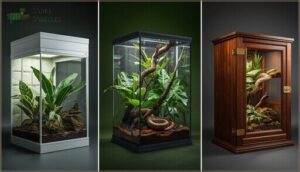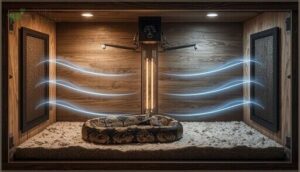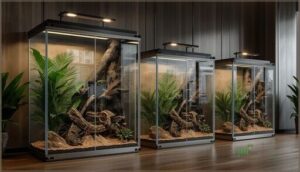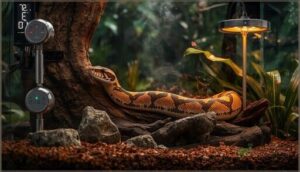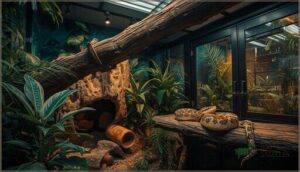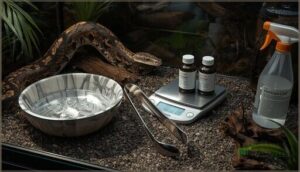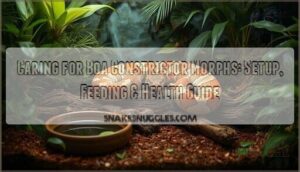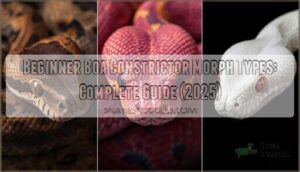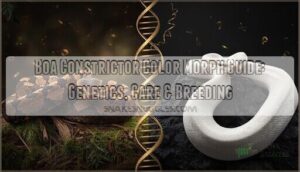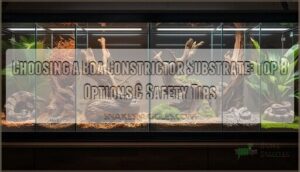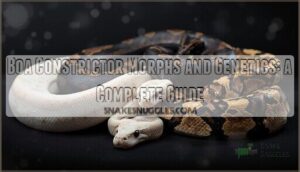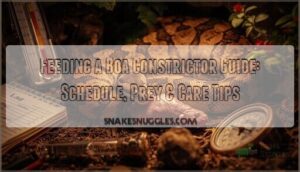This site is supported by our readers. We may earn a commission, at no cost to you, if you purchase through links.
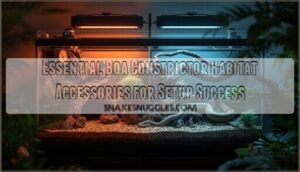
Your enclosure might impressive with its branches and water bowl, but without proper heating gradients, humidity control, and strategic enrichment placement, you’re practically asking a tropical ambush predator to adapt to your living room.
The right combination of essential boa constrictor habitat accessories transforms a glass box into a microenvironment that mimics the humidity swings and temperature zones your boa would navigate in its natural range. Getting these fundamentals right from day one prevents expensive vet visits and the heartbreak of watching your snake struggle through preventable health issues.
Table Of Contents
Key Takeaways
- Your boa’s enclosure foundation determines long-term health more than any other factor, with PVC materials retaining 15-35% more heat than glass while reducing humidity fluctuations by 30%, preventing the respiratory infections and feeding refusals that typically appear around month three.
- Temperature gradients (86-90°F basking to 75-80°F cool side) and humidity levels (55-75%) require precise monitoring through digital thermometers, hygrometers, and thermostats calibrated monthly, since placement errors alone can cause 7°F reading deviations that lead to preventable health crises.
- Boas use hiding spots 68-92% of their daytime hours, and stressed snakes without proper cover refuse food 45% more often, making at least two opaque hides (one per temperature zone) essential for reducing stress-related health problems.
- Front-opening enclosures eliminate the predator-from-above trigger that causes defensive strikes while escape-proof locks prevent the surprisingly strong push force boas can exert on unsecured doors, combining to create safer handling and containment.
Choosing The Best Enclosure for Your Boa
Your boa’s enclosure is the foundation of everything else you’ll do for their care. The right setup grows with your snake and makes daily maintenance easier while keeping your animal healthy.
Let’s look at the key features that separate a good enclosure from a great one.
Recommended Sizes by Age and Growth
Your boa’s enclosure needs will change dramatically as it grows from a 20-inch hatchling to a powerful 8-foot adult. Here’s what you’ll need at each stage:
- Juvenile boas (under 3 feet) thrive in 40-gallon enclosures that prevent stress from too much open space.
- Sub-adults (3-6 feet) require 120-gallon tanks as their activity levels increase.
- Adult boas need custom builds measuring at least 6’x3’x3′ to accommodate their full size.
These growth considerations ensure your snake always has appropriate room without feeling exposed or cramped.
Material Options: PVC, Wood, and Glass
Once you’ve decided on size, the substrate material of your reptile enclosure becomes your next critical choice. PVC enclosures retain heat 15-35% better than glass terrariums and maintain humidity with 30% less fluctuation. Glass weight can exceed 60 pounds for a 4’x2’x2′ setup, while comparable PVC weighs just 35-40 pounds.
Wooden vivariums offer strength but risk rot above 70% humidity despite sealing efforts. For reptile owners prioritizing durability and safety, HDPE enclosures are a popular choice.
| Material Feature | PVC vs Glass Performance |
|---|---|
| Heat Retention | PVC loses 25-40% less heat than glass |
| Cost Comparison | DIY PVC runs $200-$417; glass costs more upfront |
| PVC Durability | Lasts 5-10 years; HDPE exceeds 20+ years |
Wood toxicity isn’t the concern—bacterial buildup in compromised sealant is.
Front-Opening Doors and Access Features
Opening your enclosure from the front rather than lifting off a top screen changes everything about how your boa perceives interaction sessions. Front-opening doors eliminate the predator-from-above trigger that causes defensive strikes.
Here’s what you gain with front access:
- Stress reduction through lateral approach mimicking ground-level interaction
- Easy access for daily maintenance without dismantling lighting fixtures
- Boa safety when you’re reaching in—no risk of dropping heavy lids
- Cleaning ease with wide door swing and full interior visibility
- Enclosure security features like secure locks prevent escapes during routine care
Escape-proof locking mechanisms aren’t optional—they’re mandatory for boa containment.
Ventilation and Heat Retention Benefits
Proper airflow design makes the difference between a boa that thrives and one that struggles with respiratory infections or temperature swings. Ventilation screens positioned on opposite sides create cross-ventilation without losing heat retention benefits.
PVC and wood enclosures excel at insulation compared to glass tanks, cutting your heating costs while maintaining stable gradients. You’ll need less frequent seasonal adjustments when your enclosure holds warmth efficiently—especially important during winter months when ambient room temperatures drop.
Stackable and Expandable Enclosure Designs
Growing with your snake instead of buying multiple enclosures saves you hundreds of dollars and eliminates the stress of repeated habitat transfers. Modular design lets you add extension kits as your boa constrictor outgrows juvenile dimensions.
Stackable reptile enclosure configurations increase vertical expansion in tight spaces while custom configurations adapt to your room layout. You’re building for future growth without the guesswork—space optimization that matches your snake’s natural development timeline.
Essential Temperature and Humidity Accessories
Getting the temperature and humidity right isn’t optional—it’s the foundation of your boa’s health. You’ll need specific tools to create and monitor the thermal gradient and moisture levels that keep your snake thriving.
Here’s what belongs in every proper boa setup.
Heating Devices and Placement Tips
Your heating devices create the foundation for proper temperature gradients inside the enclosure. Radiant heat panels mounted on the ceiling work best, delivering 86-90°F basking spots while the cool side stays at 75-80°F. Always use guard boxes around ceramic heat emitters—unprotected units reach 950°F and cause fatal burns.
Most boas tolerate nighttime drops to 68°F safely, but subspecies like B. c. nebulosa need 80°F maintained with thermostats controlling lightless heat sources. A temperature gradient is essential for boas to regulate their body temperature.
Thermometers, Hygrometers, and Thermostats
You’ll need accurate monitoring tools to track your enclosure’s climate. Digital thermometers and hygrometers outperform analog models by maintaining error rates under 2% versus 5-10% deviations.
Place thermometer probes at your boa’s activity level—poor placement causes 7°F reading errors. An infrared thermometer lets you check basking surface temps with ±0.5°F precision.
Thermostats prevent burns and automate heating devices, with dimming types keeping fluctuations within ±1°F. Calibrate devices every three months to maintain reliability.
Maintaining Proper Temperature Gradients
Your boa’s enclosure needs a temperature range that mimics the thermal choices wild snakes make when they move between sun-warmed rocks and shaded forest floors. Position your basking lamp on one end to create the warm side at 86-90°F while the opposite end stays 75-80°F. Adjust heat bulb wattage seasonally—boas naturally experience cooler winters.
Use infrared monitoring to verify surface temps where your snake actually rests, and check thermostat calibration monthly to prevent dangerous temperature spikes.
Humidity Control: Misters, Foggers, and Substrate
Maintaining humidity levels between 55-75% prevents shedding complications and respiratory stress. Monitor with a digital hygrometer to catch humidity risks before they affect your snake’s health.
Manual misting, done once or twice daily, raises humidity without saturating the substrate. Foggers, on the other hand, create atmospheric moisture but require diligent maintenance.
Substrate layering with coconut fiber or sphagnum moss retains moisture better than paper-based choices.
Selecting The Right Substrate and Depth
Your substrate choice matters more than you might think. It affects humidity levels, cleaning routines, and your boa’s comfort during the shedding process.
Let’s look at a popular option that checks the right boxes for both beginner and experienced keepers.
1. Reptile Coconut Chip Bedding Block
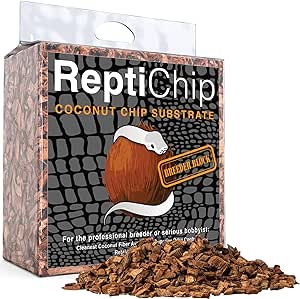
Coconut fiber substrate is one of the smartest substrate material options for boa constrictor enclosures when you need both humidity retention and odor control. This 72-quart compressed brick expands to roughly four times its size and creates a 3-4 inch layer perfect for boa burrowing behavior.
The organic coco chips absorb odors naturally while maintaining the 60-70% humidity your boa needs during shed cycles. Substrate choices matter for bioactive potential too—coconut fiber encourages beneficial microorganisms that break down waste.
The expansion ratio means you’re getting about 10 pounds of bedding that stays loose enough for your snake to move through comfortably.
Best For: Boa constrictor owners who need a natural substrate that maintains proper humidity levels while controlling odors and supporting burrowing behavior.
- Expands to 72 quarts from a 10-pound compressed brick, providing excellent value and creating a 3-4 inch layer ideal for boa burrowing
- Maintains 60-70% humidity naturally, which is essential for healthy shed cycles in boa constrictors
- Absorbs odors effectively and supports bioactive setups by encouraging beneficial microorganisms that break down waste
- Can be dusty during the expansion process, requiring caution or wearing a mask when preparing the substrate
- Requires careful watering to prevent over-saturation and potential mold growth in the enclosure
- Higher price point at $34.95, though the quality and performance may justify the cost for serious reptile keepers
Security and Enrichment Features
Your boa’s enclosure needs more than just the right size and temperature. It also needs features that keep your snake secure and mentally engaged.
Let’s look at the key accessories that prevent escapes and create a stimulating environment your boa will actually use.
Secure Locks and Escape Prevention
If your boa happens to push open an unsecured door even once, you’ll quickly learn why proper locks aren’t optional—they’re the difference between a safe pet and a neighborhood search party. Boa constrictors possess surprising strength that easily overcomes basic latches.
Quality enclosures feature secure locks with escape-proof design that account for this power. Check your locking mechanisms monthly for wear and test enclosure integrity after any adjustments. These preventative measures protect your boa and give you peace of mind.
Hiding Spots: Caves, Skulls, and Visual Barriers
Locks keep boas inside, but hiding spots give them a reason to feel secure. Research shows boas use hides 68% to 92% of their daytime hours, and stressed snakes without proper cover refuse food up to 45% more often.
Place at least two hides—one warm side, one cool—using resin caves or skulls with opaque walls that block light completely. Ground-level options get used 2.5 times more than elevated ones, and entrance width should match 1.5 times your boa’s widest body point for comfortable access.
Climbing Structures and Jungle Vines
While your boa will spend most hours tucked away in hides, vertical space triggers natural climbing behaviors that reduce stress and build muscle tone. Install sturdy climbing branches at least 1.5 times your snake’s diameter to support full body weight without bending.
Cork logs and jungle vines create climbing opportunities that mimic an arboreal boa setup, letting your snake weave between levels and express natural behaviors through enrichment variety and naturalistic design appropriate for its size.
Product Reviews: Climbing Toys and Vine Decor
Popular climbing accessories that hold up to daily use include cork branches in large and small sizes, with the Exo Terra skull series adding visual interest while doubling as climbing anchors for jungle vines. Natural cork textures provide mental stimulation through decor texture variety, while vine material safety depends on avoiding sharp edges.
Confirm branch diameter options against your boa’s girth to guarantee climbing structure stability. Strategic enrichment item placement creates arboreal boa setup opportunities that encourage weaving between levels.
Water, Feeding, and Health Maintenance Supplies
Your boa’s day-to-day needs depend on the right water, feeding, and health supplies. These accessories keep your snake hydrated, well-fed, and in prime condition throughout its life.
Let’s look at the essential items that make daily care straightforward and stress-free.
Water Bowl Sizing and Placement
Your boa needs a water bowl large enough to soak in when it’s time to shed—think bathtub, not teacup. Choose heavy ceramic or resin bowl material for spill prevention since boas are surprisingly strong. Water depth should allow full submersion while keeping your snake’s head above water.
Place it on the cool side of your reptile enclosure to help maintain humidity levels without overheating the water source.
Clean the water bowl every two days to meet hydration requirements and prevent bacterial growth.
Feeding Tools and Safe Handling
Feeding tongs keep your fingers safely out of the strike zone when it’s time to offer prey. A snake hook helps you safely maneuver your boa during cage cleaning or health checks.
Store frozen rodents in a dedicated freezer container to prevent contamination. Use feeding tweezers for smaller prey items and keep feeding dishes clean between meals.
Proper waste disposal tools protect you during routine maintenance tasks.
Shedding Aids and Humid Hides
During the days leading up to a shed, increasing humidity to 70-85% helps your boa shed cleanly. A humid hide—a commercial hide or half flower pot lined with damp sphagnum moss—placed on the cool end gives your snake a moisture-rich retreat. Digital hygrometers track relative humidity accurately.
If retained shed appears, soak your boa in lukewarm water for 10-15 minutes, then gently rub problem areas.
Product Reviews: Rock Water Dish, Calcium Supplement
Two inexpensive products—a natural-looking rock water dish and a calcium supplement—make a noticeable difference in your boa’s daily hydration and long-term bone health.
- Dish Material: Heavy ceramic or resin rock bowls resist tipping and blend into naturalistic substrate layouts
- Water Quality: Change water every 2-3 days to prevent bacterial buildup near hiding spots
- Calcium Source: Dust feeder rodents lightly with calcium powder before offering
- Supplement Dosage: Young boas benefit from supplementation every 3-4 feedings
- Boa Hydration: Monitor drinking behavior—healthy snakes soak regularly in their water bowl
Cleaning Tools and Health Monitoring Equipment
Keeping your boa healthy starts with spotting problems early—and that means tracking weight, watching shedding cycles, and keeping the enclosure cleaner than you’d probably keep your own kitchen. Digital thermometers and hygrometers verify conditions daily.
Feeding tongs and snake hooks protect both you and your snake during interaction. A digital scale tracks weight trends that signal reptile health shifts.
Waste removal tools, disinfectant-safe cleaning supplies, and regular veterinary consultations form your preventative care foundation.
Frequently Asked Questions (FAQs)
What lighting schedule works best for boa constrictors?
Most boas thrive on a consistent 12-hour day-night cycle that mimics their natural circadian rhythms. Timer automation simplifies this process.
Basking lamps create necessary heat gradients, while UVB lighting offers metabolic benefits. Seasonal lighting adjustments can improve their overall wellbeing.
How often should I replace UVB bulbs?
UVB bulbs degrade over time even when they still emit visible light. Replace them every 12 months to maintain peak UVB output for your boa’s calcium metabolism and overall health.
Can I use live plants in my enclosure?
Yes, you can use live plants in a bioactive enclosure. Choose non-toxic species and verify proper plant selection for boa safety.
Live plants boost humidity and create naturalistic environmental enrichment, but increase maintenance needs in your vivarium.
What background or wall decor is boa-safe?
Non-porous backgrounds work best for your reptile enclosure. Textured foam panels and cork bark flats attach securely while staying easy to clean.
Avoid adhesives your boa can reach during installation to maintain safe materials throughout your reptile habitat creation.
How do I prevent substrate mold and bacteria?
A keeper once lost three boas to respiratory infections—all traced back to moldy cypress mulch in a poorly ventilated rack system.
One keeper’s moldy substrate in poor ventilation killed three boas from respiratory infections
You’ll prevent substrate mold and bacteria through proper ventilation and airflow methods that keep air moving. Mix substrate monthly, remove waste immediately, and replace damp sections promptly.
Aspen bedding resists mold better than cypress mulch in humid setups.
Conclusion
Think of your enclosure setup like building a foundation for a house—cut corners now, and everything shifts later.
The essential boa constrictor habitat accessories you’ve explored aren’t just shopping list items. They’re the difference between a snake that thrives for decades and one that limps through chronic stress.
Your boa can’t tell you when the gradient’s off or humidity’s dropping. These tools speak for them, giving you real-time data to catch problems before they become emergencies.
Get the fundamentals right, and everything else falls into place.
- https://www.reptifiles.com/affiliate-disclosure/
- https://reptilesupply.com/collections/reptile-decor
- https://www.visionproducts.us/blog/reptile-enclosure-materials/
- https://www.reddit.com/r/ballpython/comments/b8209h/will_wood_enclosure_hold_humidity/
- https://talis-us.com/blogs/blog-288/wood-vs-pvc-for-reptile-cages-an-expert-comparison


